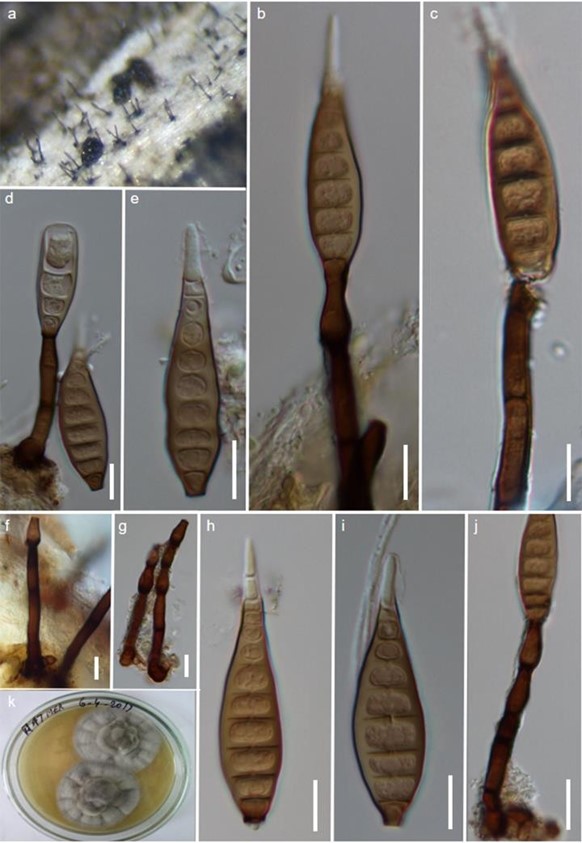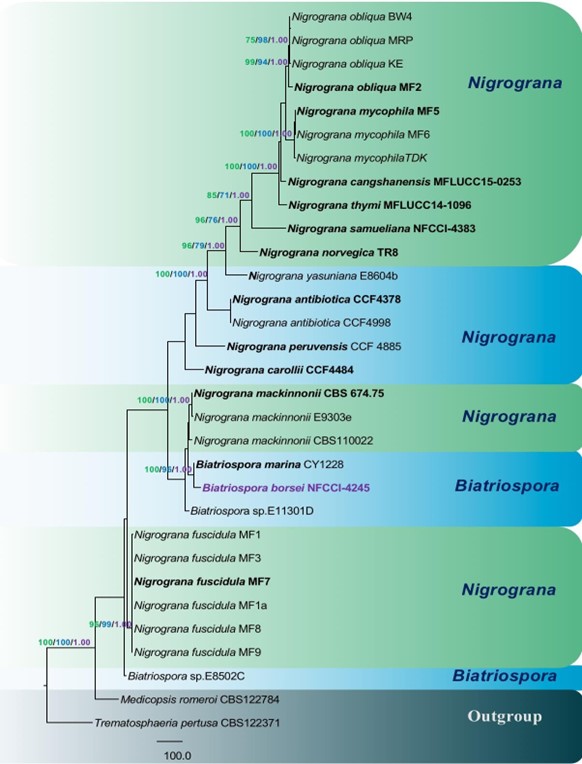Biatrisopora borsei B. Devadatha, V.V. Sarma sp. nov. Fig. 56
MycoBank number: MB 555778; Index Fungorum number: IF 555778; Facesoffungi number: FoF 06529.
Etymology – Specific epithet in honour of Indian marine mycologist Dr. B.D. Borse on his contributions to marine mycology.
Saprobic on decaying wood of Avicennia marina Sexual morph: Undetermined. Asexual morph: Colonies on natural substratum velvety to olivaceous brown. Mycelium mostly superficial, comprising pale to medium brown, smooth or verrruculose, septate, extensively ramifying hyphae. Setae and hyphophodia absent. Stromata not developed. Conidiophores 40–115 × 2.5–6 µm (x̅ = 68 × 5 µm, n = 10), borne on superficial smooth, hyaline knots of hyphae, solitary or aggregated, straight to slightly flexuous, cylindrical, pale to medium brown uniform in width and colour, unbranched, smooth, 2–5 septate, not cicatrized, with one percurrent proliferation. Conidial secession schizolytic. Conidia 30–45 × 7–9 µm (x̅ = 43 × 8 µm, n = 10), subclavate, slightly rostrate, straight or slightly asymmetrical, rounded at the tip, pale brownish, apical cell usually hyaline, mostly with 6 pseudosepta, rarely 7-pseudoseptate, not constricted at septa obconically truncate at the base usually with a darkened hilum.
Culture characteristics – Conidia germinating on 2 % sea water agar within 24 h with germ tubes produced from terminal ends. Colonies on malt extract sea water agar fast growing, reaching diameters of 30 to 50 mm in 25 days at room temperature, gray to dark brown, cottony, circular, raised, zonate; reversed colonies brown.
Material examined – India, Tamil Nadu, Tiruvarur, Muthupet mangroves (11.24°N 79.5°E), on decaying wood of Avicennia marina (Acanthaceae), 28 November 2016, B. Devadatha, AMH- 9943 (holotype), ex-type living culture, NFCCI-4245.
GenBank numbers – ITS: MK358818; LSU: MK358813; SSU: MK358811; tef1: MK330938.
Notes – Biatriospora borsei resembles Elliembia repentioriunda in morphological features such as conidiophores borne on superficial hyphae and conidia that are sub-clavate, slightly rostrate, 6–7 pseudoseptate, apical cell hyaline and similar conidial dimensions. However, B. borsei differs from Ellisembia repentioriunda in having longer conidiophores (30–45 × 7–9 µm vs 15–35 × 3.5–4.5), in lacking hyaline, subglobose mucilaginous sheaths in the apical cells and by its occurrence in marine habitats. Ellisembia gelatinosa and E. minigelatinosum differ from B. borsei in having conidiophores that arise from vegetative hyphae and conidia with a mucilaginous sheath at the apex (Goh & Hyde 1999). The Ellisembia species compared here lack molecular data for any comparisons of their phylogenetic relationships.
The combined ITS, LSU, rpb-2, SSU, and tef1 sequence datasets comprised 31 strains of Nigrogranaceae and Biatriosporaceae families with Trematosphaeria pertusa and Medicopsis romeroi as the outgroup taxa (Fig. 57). It is topologically similar and congruent with previous studies (Hyde et al. 2013, Jaklitsch & Voglmayr 2016, Ahmed et al. 2018). Our new taxon formed a monophyletic clade along with Biatriospora marina (CY 1228) with significant bootstrap support (ML 100 %, MP 71 %, and 1.00 PP, Fig. 57). Biatriospora marina is a sexual morph, whereas B. borsei is an asexual morph. Both are reported from decaying wood from mangroves (Hyde & Borse 1986). The morphological details and the multi-gene phylogenetic results suggest that B. borsei is a novel species. Hence, based on above observations, we introduce B. borsei as a new species.

Figure 56 – Biatriospora borsei (AMH-9943, holotype). a Colonies superficial on the surface of decaying wood. b–d, j Conidiophore bearing conidia. f, g Conidiophores k Culture on MEA after 30 days of incubation. e, h, i Conidia. Scale bars: b–j = 10 μm.

Figure 57 – Phylogram generated from Maximum Parsimony analysis of Biatriospora species and related genera based on ITS, LSU, rpb-2, SSU and tef1 sequence data. Bootstrap support values for maximum likelihood (ML, green), maximum parsimony (MP, blue) equal to or greater than 70 % and the values of Bayesian posterior probabilities (PP, purple) equal to or greater than 0.95 are given above each branch, respectively. The tree is rooted to Medicopsis romeroi (CBS 122784) and Trematosphaeria pertusa (CBS 122371). The new isolate is in purple.
